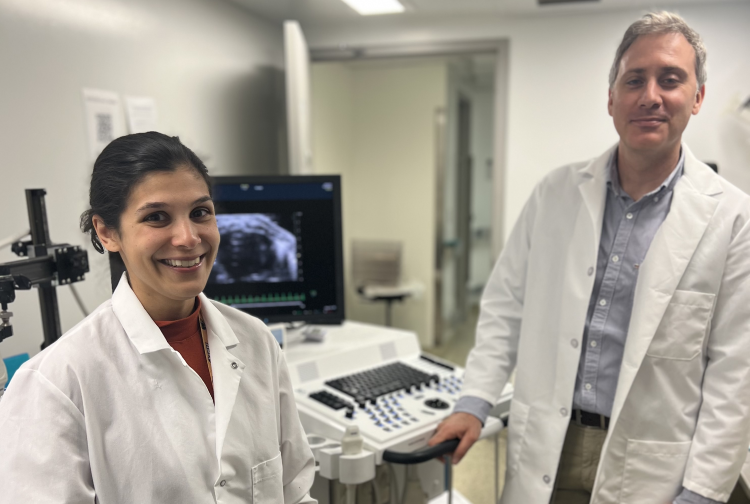New Enzyme Linked to Changes in Heart Tissue After Heart Attack
Discovery offers a possible new therapeutic pathway for the treatment of ischemic heart failure
May 20, 2024 Pauley Heart Center researchers Anna Kovilakath, PhD, and Gabriele Mauro, PhD were the study's lead authors
Pauley Heart Center researchers Anna Kovilakath, PhD, and Gabriele Mauro, PhD were the study's lead authors
Research coming from the Pauley Heart Center and the VCU School of Medicine is providing new insights into the molecular underpinnings of heart failure. Published this week in Circulation, the findings shed light on a newly discovered metabolic pathway that contributes to heart injury. The study found that an enzyme known as SPTLC3 is detected in the cells of hearts that have experienced heart failure due to ischemia.
The research team made the initial discoveries in a mouse model of ischemic heart failure, finding that when production of SPTLC3 was limited in mouse cells, related cellular symptoms of heart failure—such as inflammation and scarring—were also reduced. Importantly, these findings were then validated and confirmed in cardiac tissues from patients with end-stage ischemic heart failure, leading to the conclusion that SPTLC3 may exert a previously unrecognized impact on the heart metabolism following a heart attack.
What this means is that inhibiting SPTLC3 may serve as a tangible way—a new therapeutic target—to improve health outcomes in patients with ischemic heart failure.
Ischemic heart disease occurs when blood flow to the heart is reduced, usually due to arteries that are narrowed or obstructed by a buildup of plaques. (“Ischemia” means a decrease in blood supply to any part of the body.) When coronary blood flow is reduced, the flow of oxygen and nutrients to heart muscle cells is also reduced, and the heart cannot work as it should. Reduced blood flow and concurrent oxygen deprivation can ultimately lead to heart attack, and SPTLC3 may play an important role in the damage that occurs to cells after heart attack.
The study arose from a collaboration between Ashley Cowart, PhD, a professor in the VCU School of Medicine's Department of Biochemistry and Molecular Biology and director of VCU's Lipidomics and Metabolomics Shared Research core, and Fadi Salloum, PhD, FAHA, interim chair of the School of Medicine's Department of Physiology and Biophysics and the Natalie N. and John R. Congdon Sr. Endowed Chair in the Pauley Heart Center. Cowart is an expert in lipid metabolism and signaling, while Salloum has extensive experience in modeling and imaging heart injury, and also administers the Pauley Heart Center's Tissue Biobank.
“VCU has historical strength in both lipid research and cardiovascular research,” Cowart said. “A major strength of this work is rooted in our collaboration across these two fields. We were able to combine expertise and cutting-edge technologies in both cardiac imaging and lipid biochemistry. Additionally, the Pauley Heart Center's tissue repository enabled us to link our findings to human health.”
“Bringing together researchers from different scientific backgrounds is what we do at the Pauley Heart Center,” Salloum said. “We collaborate across departments and schools at VCU to advance discovery in cardiovascular medicine.”
Together, Cowart and Salloum conceptualized the scientific questions, designed the experimental protocol, and mentored the lead author of the publication, Anna Kovilakath, PhD. Kovilakath, who is now a T32 postdoctoral fellow at Pauley, carried out the majority of the research studies with the help and guidance of Gabriele Mauro, PhD, who recently completed his Pauley T32 postdoctoral fellowship in the Salloum laboratory.
“Having lost family to cardiovascular disease, I've chosen to dedicate my career to studying sphingolipids in the context of heart disease,” Kovilakath said. “It's a meaningful way for me to contribute to understanding and combating this global health issue."
At the Pauley Heart Center, “training is really, really key,” Salloum said. “Mentorship is something we do really well here—and you can see that in the retention of our talented trainees.”
Other key collaborators from the Pauley Heart Center include Ed Lesnefsky, MD, and Qun Chen, PhD, both of whom offered invaluable insight and expertise in conducting mitochondrial studies, and Frank Raucci, MD, PhD, whose expertise was instrumental in executing the single cardiac muscle cell studies.
Click here to view the full manuscript of this publication.










.png)
.jpg)